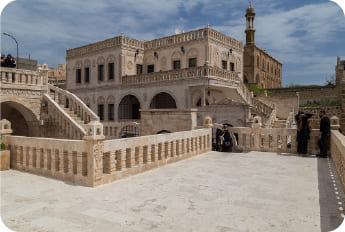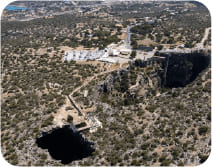



Minimum group size: 4 people

Tour price:
/to be confirmed/

Diyarbakır

Dara

Harbiye Waterfalls

Silifke Castle

Mersin
We will meet at Antalya Airport and take a flight to Diyarbakır. Upon arrival, we have breakfast and start the tour.
Diyarbakır. Travelers will marvel at the massive basalt walls of the old city, recognized as a UNESCO World Heritage Site. Diyarbakır is considered one of the largest fortresses in the world. Behind these walls lies an ancient oriental city with towering minarets and bustling caravanserais. We will stroll through its narrow streets, visit the old Ulu Mosque, and then move on to the antique city of Hasankeyf, which is at risk of being flooded. Here, we will make a stop to observe the still-visible traces of history.
Hasankeyf. The history of Hasankeyf is both fascinating and tragic. The northern Mesopotamian region, specifically the caves above the Tigris River, is considered one of the birthplaces of the earliest Neolithic communities, marking the dawn of our civilization. Since ancient times, this area has been a vital river crossing, utilized by the Sumerians, Assyrians, and Babylonians. The ever-expanding Roman Empire built a fortress nearby, known as Cepha. Today, its ruins, alongside remnants of Byzantine churches, are scattered across the scarred landscape of the city, with towering minarets standing above it all.
It was here that Joscelin de Courtenay, Count of Edessa, was imprisoned after being captured by Muslims following the Crusaders' devastating defeat at Harran. Shortly after his captivity, in 1116, the most magnificent bridge in the Middle East was constructed across the Tigris, later partially destroyed by an earthquake.
This city, a metaphorical "grandfather" to our civilization, has since become a remote Kurdish province. Yet, even now, it has the power to leave a profound impression on those who visit it.
Midyat. The next stop on our itinerary is the city of Midyat. We will visit the Governor's Guest House, a fascinating example of regional architecture and the filming location for many famous television series. We'll also see the old inn on Telkariçiler Street, where you can shop for souvenirs and sweets if you wish. After the stroll, we'll check into our hotel, enjoy dinner, and relax.
Dara. After breakfast, we will visit the abandoned early Byzantine city of Dara near the Syrian border. Once a vital center of Mesopotamia, Dara was home to numerous temples and palaces. Today, it stands as one of the historically significant sites in Turkey.
Mardin. Next, we’ll head to Mardin, where we’ll explore the square and main street of the old town. We'll discover the abbara, which is vaulted passages between walls in the narrow alleys. Highlights include the Church of the Virgin Mary (now the Mardin Archaeology and Ethnography Museum), the Zinciriye Madrasah, and the Şehidiye Mosque. We’ll also visit the Deyrulzafaran Monastery and the Kasimiye Madrasah, before enjoying a stunning sunset over the Mesopotamian plains.
In the evening, our guests will enjoy dinner at the hotel.
Göbekli Tepe. In the morning, we’ll visit the Göbekli Tepe temple complex, an extraordinary megalithic site built over 12,000 years ago. Guests will learn about its fascinating history and marvel at the ancient temples that reflect the beliefs of prehistoric civilizations.
Harran. Next, we’ll head to Harran, an ancient Mesopotamian city over 10,000 years old, home to the world’s first Islamic university. We’ll explore the ruins of the Grand Mosque, the ancient mound, city walls, the castle, and admire the unique architecture of traditional Harran beehive houses.
Şanlıurfa. We’ll continue to Şanlıurfa, where we’ll visit the Cave of Abraham. According to legend, the prophet hid there for 15 years from King Nimrod, who had ordered the killing of all infants born in the year of Abraham’s birth. We’ll also see the castle and Halil-ür Rahman Mosque, and take a stroll around the beautiful Aynzeliha and Balıklıgöl lakes. Before heading to the hotel, there will be free time to explore the vibrant old bazaars of the city.
Sıra Night. In the evening, a special treat awaits, a traditional Sıra Night. Guests will enjoy authentic folk dances and music performed with regional instruments, creating a memorable cultural experience before settling in for the night.
Birecik. This day begins with a visit to the town of Birecik on the banks of the Euphrates River, renowned for its sanctuary dedicated to the endangered bald ibises. At the reserve, our guests will learn about this rare bird species and ongoing conservation efforts.
Halfeti and Savaşan. Next, we’ll take a one-hour drive to Halfeti, a town which is located on the Euphrates as well. Much of Halfeti has been abandoned due to flooding caused by the construction of a dam. We’ll explore its key landmarks before heading to the village of Savaşan, where parts of the settlement remain underwater, creating a surreal and photogenic landscape.
Adıyaman. Our journey continues to Adıyaman, a historically significant trade center during the Ottoman Empire and an important stop along the Silk Road between Anatolia and Persia.
Mount Nemrut. Mount Nemrut (Nemrut Dağı) is a breathtaking Turkish landmark and a UNESCO World Heritage Site since 1987. This national park houses a sanctuary and the tomb of King Antiochus of Commagene.
We’ll visit the Cendere Bridge and Karakuş Tumulus, an ancient royal burial site and mausoleum for the women of the Commagene royal family. King Mithridates II of Commagene built this tomb in honor of his mother, Isias, as noted in an inscription on the stone.
From there, we’ll drive to the base of Mount Nemrut and hike for about 30 minutes to reach the summit, famous for its unique stone statues from the Hellenistic period. Legend has it that the slopes of Mount Nemrut offer some of the most spectacular sunsets in the world, so it’ll be an experience we won’t miss.
Afterward, we’ll return to Adıyaman for dinner and an overnight stay at the hotel.
After breakfast, we’ll travel to Gaziantep, where we will visit the famous Zeugma Mosaic Museum, one of the richest collections of its kind in the world.
Mosaic Museum. Opened on September 9, 2011, the museum showcases an extensive collection of ancient mosaics, primarily from the ancient city of Zeugma. These mosaics were uncovered during archaeological excavations conducted in the area before the construction of the Birecik Dam.
After exploring the Mosaic Museum, we’ll stroll through local bazaars to shop for regional delicacies and souvenirs. In the afternoon, we’ll check into the hotel. Dinner will be served in the evening.
St. Peter’s Church. Today, we head to Hatay Province, where our first stop is the cave church and museum of St. Peter in Antakya. One of the world’s first Christian churches, it is a revered pilgrimage site visited by people from across the globe.
Museum Hotel. Next, we’ll visit the Museum Hotel, home to a large monolithic floor mosaic uncovered during excavation work in 2009 while constructing the hotel.
Harbiye Waterfalls. Our final stop is a picturesque gorge to admire the beautiful Harbiye Waterfalls, a series of small cascading streams nestled in serene surroundings./p>
Adana. After breakfast, we head to Adana. Travelers will admire the 32-meter historic clock tower, crafted from finely hewn stones. We'll visit the Sabancı Mosque, featuring six minarets and visible from almost any point in the city, it’s a true symbol of Adana. Additionally, we'll explore the stone bridge dating back to the 4th century, formerly known as the Justinian Bridge.
Following the tour, guests will have free time for dinner (we highly recommend trying the Adana kebab) and shopping.
Mersin. Mersin offers a wide array of attractions, including historical and cultural landmarks, natural wonders, and bustling social hubs.
The surrounding area of modern-day Mersin has been inhabited for over 8,000 years. Excavations at Yumuktepe Hill on the city outskirts have revealed dozens of historical layers, with the oldest dating back to around 6300 BCE. Throughout its long history, Mersin has been part of many civilizations, including the Hittites, Assyrians, Persians, Greeks, Romans, and Byzantines. During the Hellenistic period, the city was known as Zephyrium and was well-regarded for its natural harbor and strategic position on southern Anatolian trade routes.
Our itinerary will take us to some of Mersin's most fascinating locations, though there is even more to explore here.
Mersin Marina. Mersin boasts one of Turkey's most beautiful yacht harbors. Beyond the luxury yachts, the marina offers a rich infrastructure with restaurants, bars, cafés, and shops.
Aynalıgöl Cave. Discovered by a shepherd in 1999, this cave lies right on the seashore. Its entrance, located 45 meters above the ground, leads to a stunning lake at the end of the cave. The cave takes its name, Aynalıgöl, meaning "Mirror Lake" in Turkish, due to the water’s smooth, reflective surface.
Caves (Gorges) of Heaven and Hell. Known in Turkish as Cennet and Cehennem, these two caves exude a truly mesmerizing atmosphere. Travelers often feel transported to another dimension. According to legend, Zeus temporarily confined Typhon in the Hell Cave (Cehennem) before trapping him under Mount Etna.
Maiden's Castle. Maiden's Castle is perhaps the most iconic site in Mersin. Built in the 12th century, this large ancient fortress is located on a small island, adding to its allure and historical significance.
Anemurium. The ruins of this ancient city, now known as Eski Anamur, are located a few kilometers away from the modern Turkish city of Anamur. Anemurium was once part of the Roman province of Cilicia. The site holds a wealth of historical significance and features remnants of its glorious past.
Mamure Castle. This well-preserved medieval fortress lies near Anamur in Turkey’s Mersin Province. Positioned on the Mediterranean coast, the castle is especially striking when viewed from the sea. Originally commissioned by a ruler of Armenian Cilicia, the fortress was constructed atop a Roman stronghold dating back to the 4th century.
Covering an impressive area of 23,500 square meters, Mamure Castle underwent restorations in the 15th, 16th, and 18th centuries. Parts of the fortress were later converted into an inn for merchants traveling with caravans.
The castle features towers and bastions connected by broad walls, which visitors can walk along. However, there are no railings, making such exploration suitable only for the most daring and cautious tourists.
The castle contains three inner courtyards. The western courtyard houses a small mosque with a single minaret and the partially ruined remains of a Roman bath. The southern courtyard features the remnants of a lighthouse.
Mamure Castle offers a fascinating glimpse into the architectural ingenuity and strategic importance of the region throughout its history.
Silifke Castle. The ruins of the medieval Silifke Castle are situated on a small hill rising to the west of the center of the Turkish city of Silifke, which was once known as ancient Seleucia on the Calycadnus. The castle is visible from any point in the city. Visitors can reach it by a steep staircase that encircles the hill.
Archaeological excavations are currently ongoing on the castle grounds, but the site remains open to tourists, offering not only a chance to explore the ancient structure but also to climb one of the surviving towers, from which panoramic views of both the city and the southern part of the Goksu Valley can be enjoyed.
Silifke Cistern. This large reservoir, built during the Byzantine era to collect and store drinking water, is located at the base of the hill on which Silifke Castle stands. The Turks call this place Tekir Anbari, which translates to "striped storage." The cistern was constructed within a natural cave.
The rectangular-shaped reservoir measures 46 meters in length and 23 meters in width, with walls rising about 12 meters. The walls are made of stone in the form of false arches, and each arch features horizontal markings that were used to measure the water level. The cistern could hold about 12 tons of water. The bottom of the cistern is now covered with grass and shrubs, adding a natural touch to the historical site.
Olba or Olvia. Olba (also known as Olvia) is an ancient city located near the village of Uzuncaburç. It was founded in the 3rd century BC and grew and developed over many centuries. Over time, new public and residential buildings, as well as various structures, were constructed here. Some of these have survived to the present day, such as the partially ruined Roman aqueduct, which is one of the main attractions of Olvia.
The aqueduct was built under the orders of Roman Emperor Septimius Severus in 199 AD. The two-level structure was inscribed with the words: "For the people of the city of Olba". Significant restoration of the aqueduct took place in 566 AD during the reign of Byzantine Emperor Justinian I. Today, only fragments of the aqueduct remain.
Aya-Fekla. The ruins of a large church complex built during the Byzantine period, Aya-Fekla was once a popular pilgrimage site. Even today, both locals and tourists visit this place to see the cave where the Christian saint Fekla once lived.
Fekla was a disciple and follower of the Apostle Paul and was deeply revered during the Byzantine period. She lived in the vicinity of present-day Silifke and passed away here. The Aya-Fekla church is located 4 kilometers south of the town of Silifke.
Silifke City. Silifke is known as the place where Emperor Frederick Barbarossa, who led the German army during the Third Crusade, met his tragic end. In 1190, while heading to Palestine, Barbarossa's army attempted to cross the turbulent Calicadnus River (now known as the Goksu River). According to legend, no one in his close circle noticed when the emperor fell into the water. His heavy armor allegedly pulled him under, and he drowned. While the exact circumstances of his death remain uncertain, there are rumors and theories suggesting foul play. To commemorate the emperor’s death, modern residents of Silifke allowed the Embassy of the Federal Republic of Germany to establish a memorial about 9 kilometers west of the city.
Demirci Village Tombs and Ruins of Imbriogon. Demirci is a small village located in the Silifke district of Mersin Province. It lies on the road connecting Silifke to Diocesarea (Uzuncaburç). Historically, Demirci was known as Imbriogon, which is believed to have been founded in the 2nd century AD. In ancient times, it served as a summer retreat for the wealthy citizens of Seleucia (modern-day Silifke). However, no references to Imbriogon from the Christian era have been found, leading scholars to believe that it was abandoned around that time.
The remains of several tombs and mausoleums are still visible in the area, dating back to the 2nd-3rd centuries AD. Seven mausoleums and temples are the main surviving structures from ancient Imbriogon. Some tombs are two stories high, reaching up to 7.5 meters in height. One of the mausoleums features Ionic columns on the first floor, standing at 2.3 meters, and Corinthian pillars on the second floor, at 2.9 meters. Inside this tomb, three sarcophagi adorned with reliefs remain, and the lower burial chamber has been carved into the rock.
On the hill near the tombs of Demirci, visitors can see the ruins of ancient Imbriogon. Notable features include the remains of an ancient bathhouse with a mosaic floor depicting a sea god and a Greek inscription. There are also columns scattered around the site, and further down the hill, a sarcophagus with its lid nearby can be found.
Alahan Monastery. In the south of Asia Minor, between the modern cities of Silifke and Konya, lies a remarkable site in the Taurus Mountains, the ancient Alahan Monastery, which is carved into the rocks. The monastery is about an hour's walk from the village of Geçimli.
The Alahan complex is an excellent example of early Byzantine architecture. Construction began in the mid-5th century during the reign of Emperor Leo I and was completed in the late 5th century under Emperor Zeno. The Alahan Monastery consists of two churches, a baptistery, rock-cut monk cells, living quarters, baths, and other structures. There is also a necropolis. Monks and pilgrims resided in the monastery until the 7th century, after which it was abandoned and forgotten for many centuries.
In the western part of the complex there is a large natural cave with vaulted ceilings approximately 10 meters high. Numerous cells, arranged across three levels, were carved within the cave. This section also houses a church, which is presumably the first of all the sacred structures in the monastery.
Köşekbükü Cave. This intriguing site is located 9 kilometers from Anamur in the Ova Bashi district. The cave comprises three sections with a total area of 500 square meters, named Huzur (Tranquility), Şifa (Healing), and Dilek (Wish). The air inside is believed to have therapeutic properties, particularly beneficial for asthma sufferers. Research indicates that approximately 20,000 years ago, during the Paleolithic era, it was inhabited by anatomically modern humans. In the early 21st century, the cave was equipped with lighting and opened to tourists.
Pulluk Natural Park. Located near the Antalya-Mersin highway, just 8 kilometers from Anamur, this park is a tranquil haven of untouched nature. Covering a little over 10 hectares, the park features walking paths and a designated camping area, making it a perfect spot for enjoying the outdoors.
Alanya. We will ascend to the Alanya Fortress, a stunning example of medieval architecture perched 250 meters above sea level. The tour will include a visit to the Sultan Suleiman Mosque and the Damlataş Cave. Along the way, there will be plenty of opportunities to capture beautiful photos on the scenic route.
On the final day, we will return to Antalya, marking the end of the tour. Afterward, travelers will depart for home.


























